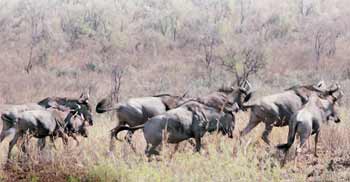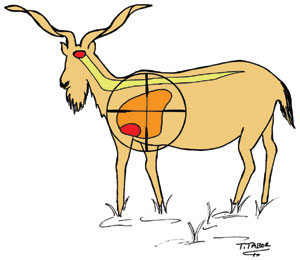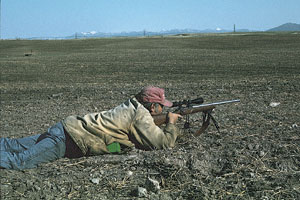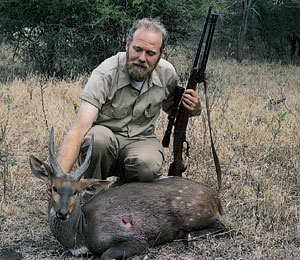Clean, humane and successful hunting
by Thomas Tabor
Hunter 3
 We’ve all heard the talk around hunting camp. It usually goes something
like this: “I always shoot for the head (or neck) because that way it is either a clean kill or a clean miss.”
We’ve all heard the talk around hunting camp. It usually goes something
like this: “I always shoot for the head (or neck) because that way it is either a clean kill or a clean miss.”
In most cases this type of statement is quickly followed up with some sort of justification that by shooting for these areas there is no meat lost as a result of bullet damage. Assertions like these often come from some boastful bloke who’s attempting to convince his captive, yet reluctant audience, as well as himself, that he doesn’t need to shoot for a larger area of the animal’s anatomy because ‘he is such a great shot’. And of course there is the issue that such shots (when successful) always produce a quick and humane kill, dropping the animal where it stands. Of course it is usually pointed out that when this occurs there is no need to follow a blood trail or try to locate a wounded animal.
But there are very serious problems associated with this whole form of mindset. In essence, the proclamation that such shots ‘produces either a clean kill or a clean miss’ could not be further from reality.
In order to make the all-inspiring clean headshot on a goat-, pig- or deer-sized animal, the shooter must be capable of consistently placing their bullet in an area not much larger in size than that of a scrawny, undernourished apple. Further adding to this monumental challenge, these shots must be achieved under actual field conditions, which in many cases are far from ideal.
Sometimes this means the shot must be squeezed off when the shooter’s breathing is severely laboured, when quick decisions and quick shots are called for and/or when steady rests are not readily available.
But, these are not the only problems associated with a headshot. Not only is the target small, it moves. The head probably moves about more than any other part of the animal’s anatomy. If a sound is heard, the head moves to see what made the noise.
If a whiff of some sort of foreign scent is in the air, the head moves to see where it came from. A small target, always on the move, equals a difficult target to hit. In addition, the brain is surrounded by heavy bone. While deer, goats, pigs and the like may not have the protective head armour that a cape buffalo or rhino is equipped with, it’s still there and under the right or wrong circumstances it can deflect a bullet.
 And, even though the vitals area of the neck is a little larger in
total area size, its width is about the same as in our earlier example
of a brain shot. In each case we are talking about target areas that
can easily be missed if the hunter’s aim is off only a couple of
inches.
And, even though the vitals area of the neck is a little larger in
total area size, its width is about the same as in our earlier example
of a brain shot. In each case we are talking about target areas that
can easily be missed if the hunter’s aim is off only a couple of
inches.
Another area of the misguided rationale is whether a head or neck shot really results in any less loss of meat as a consequence of bullet damage. While this point may have more validity associated with it than the earlier claims, it too is based on faulty logic. The much better vitals target area, the heart/lungs, also has very little worthwhile meat to be wasted or damaged.
With a broadside shot to these areas, the bullet will generally pass through or between the ribs. In most cases this will result in little damage to any form of edible meat.
In a real-world situation, opportunities are not always what we would prefer. As a result, if an animal isn’t standing perfectly broadside to the shooter, a bullet could pass diagonally through the body cavity. In this case there is potential for meat damage. Certainly, if your bullet should go through a hind or front quarter in order to reach the lungs/heart area, damage is certain to occur. These types of shots should not be taken. It is our intention here to discourage such shots whenever possible. A good hunter will only squeeze the trigger when they are certain that the end result will be a clean kill and, if hunting for meat, they should not fire if significant meat damage is probable.
In all but the rarest of situations, the safe area to shoot for is the heart and lungs area. Why would a hunter take the chance at a target the size of a very small apple if they could have a target roughly the size of a dinner plate and experience the same result? While there are times when a head or neck shot is the only practical choice, these occasions are rare.
A clean shot does not always mean that the animal will collapse instantly. In many cases a very humane, clean shot to the vitals will still result in an animal running a short distance before finally coming to rest. In most cases these animals are essentially dead upon bullet impact - their bodily functions just don’t know it yet. This is particularly the case in Africa, where game live in constant fear of predation from the time they are born until the day they die. The ability for these animals to continue going even after their vitals have been destroyed is nothing short of phenomenal.
Whenever making a shot at a game animal, the experienced hunters should never allow themselves to get carried away with the excitement of the moment. Certainly, this is not always easily accomplished. Nevertheless, the hunter’s eyes should never leave the target until it is apparent that the shot was totally successful and the fallen animal is down for the count. Once the shot has been made, another round should be immediately chambered and the shooting position maintained. The best available shooting location was likely chosen before the trigger was squeezed. Consequently, that location should not be cavalierly abandoned.
 Once the shot has been made, the hunter should continue to watch the
animal to see what it does. It is much better to not be in a rush at
this point. Bow hunters are well aware of this, yet many rifle hunters
continue to make the mistake of being too quick to their feet after the
initial shot. Somehow the sight of you, the predator, in pursuit is all
that is necessary to encourage a mortally wounded animal to keep its
bodily functions together and continue to travel.
Once the shot has been made, the hunter should continue to watch the
animal to see what it does. It is much better to not be in a rush at
this point. Bow hunters are well aware of this, yet many rifle hunters
continue to make the mistake of being too quick to their feet after the
initial shot. Somehow the sight of you, the predator, in pursuit is all
that is necessary to encourage a mortally wounded animal to keep its
bodily functions together and continue to travel.
Sometimes downed animals are difficult to locate once they are down. This is especially true when shooting at great distances. In most situations, animals are camouflaged to fit their environment and it is always amazing how well a large animal can escape detection even when laying directly in the open.
Once the animal is down, a concerted effort should be made to not only mark the location of the animal, but the location that the shot was fired from. The terrain never looks the same from a different vantage point. For this reason the few moments needed to mark both of these locations may pay great dividends later on. Marking of these locations can be accomplished by utilising easily recognisable landmarks. A couple of lines of sight markers can help. Look for hills, distinguishable trees, rocks, etc in order to get you to the right spot. If you are fortunate enough to have a GPS along, it can be used to precisely mark the location the shot was taken from. It only takes a couple of moments to store your exact position.
Having the shot site stored either in your own mind, or in a GPS’s memory, will allow you to return to that spot later on in the event that you are still unable to locate the downed animal. By doing so it will permit you to retrace the bullet flight and retrieve your game.
Certainly there will be times when a heart/lung shot is not practical or even possible. There are rare cases when the only feasible shot is one to the spine or elsewhere. If an exceptional trophy animal should appear and the hunter has no other available option but to take a shot at a less-than-perfect target location, in many cases the shot will be taken. But these cases are rare and should be avoided whenever possible. All hunters should pass up shots unless they are confident in their abilities to retrieve the animal and that the shot will result in a humane kill.
 It is easy to get in the habit of thinking in the single dimension when
shooting. After all, we shoot paper targets that are tacked onto
stumps, trees or a piece of lumber. If our bullet cuts a clean hole in
the bullseye or x-ring, that is all that is necessary. But for the
hunter it is imperative to think in three-dimension. Many times a
bullet must travel a significant distance inside the body of a game
animal before reaching any of the vitals.
It is easy to get in the habit of thinking in the single dimension when
shooting. After all, we shoot paper targets that are tacked onto
stumps, trees or a piece of lumber. If our bullet cuts a clean hole in
the bullseye or x-ring, that is all that is necessary. But for the
hunter it is imperative to think in three-dimension. Many times a
bullet must travel a significant distance inside the body of a game
animal before reaching any of the vitals.
Consequently, where the bullet enters the animal is not as important to the kill as where and how the bullet makes contact with the vitals. In other words, a bullet placed precisely behind the break of the front shoulder may look good at first glance, but could miss the heart/lungs area entirely if the animal is located below the hunter in a canyon bottom, high over head standing on a rocky outcropping or turned at an angle from the shooter. An animal canted only slightly can make a major difference in the bullet’s course of travel.
Further adding to this potential problem area is the fact that most game animals are elongated creatures, being much longer than they are wide. If a hunter isn’t recognitive of subtle and slight variations in position and appearance, a serious mistake can occur. Thinking the animal is standing perfectly broadside when in fact it is angled slightly, a shot may be placed in error resulting in the vitals being missed. For this reason it is very important for a hunter to get in the habit of studying the positioning carefully before squeezing off the shot.
Hunters should always choose the shot that will provide the most likely chance of dispatching the animal quickly and humanely. While head and neck shots sometimes fit these criteria, more often than not they don’t. The much larger target consisting of the heart and lungs area is most often a better choice. So, don’t try to be a hero through the faulty logic of the ‘clean kill - clean miss shot’ of the neck and head when there is a better choice. You and the game will both benefit from the right choice.
Captions
Image 1: Hunters should train themselves to
carefully evaluate the angle and position of the game. Study the
position of each animal in this herd of African wildebeest, then judge
where a bullet would have to enter each animal in order to make contact
with the heart/lung area.
Image 2: The shaded area of this goat silhouette
shows the main vitals area. Notice in comparison how much smaller the
head, neck and spine areas pale in size to that of the heart/lung area.
It is important to note how much of the head and neck could be struck
by a bullet, yet not result in an instant kill.
Image 3: Once a shot is fired, the hunter should
stay in position and watch to see what the animal will do. When the
vitals are hit, but the animal does not instantly drop, the best option
is to stay in position and not pressure the animal.
Image 4: The author took this fine trophy South
African bushbuck with his .300 Winchester Magnum. The animal was in
thick cover standing broadside at about 60 yards. Notice the position
of the bullet entry hole. Even though this was a close-range shot, the
temptation to shoot for the head or neck was passed up in favour of the
safer shot to the lungs.
